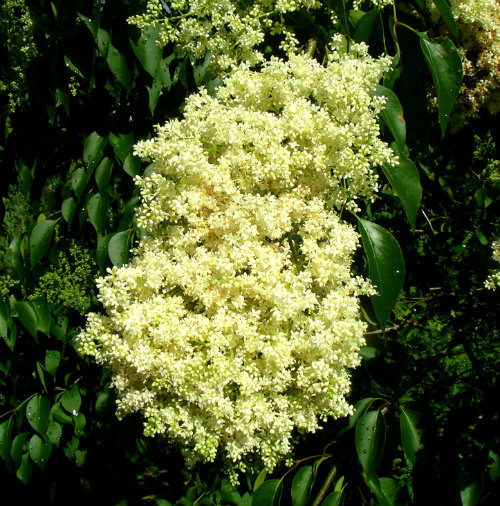Plant of the Month for February, 2018

Syringa pekinensis
(si-RING-gah pee-keen-EN-sis)
General Information:
Syringa pekinensis is a small multi-stemmed tree that would fit most gardens. It has large clusters of cream-white flowers and exceptional exfoliating bark. If it had great fall color it would be one of the most popular trees on the market, but unfortunately the leaves just go brown.

Syringa pekinensis:photo by Robert Pavlis
Most sources use the name Syringa pekinensis, but some call it Syringa reticulate subsp pekinensis. The tree shape and flowers are very reminiscent of S. reticulata but the later does not have the nice reddish bark. Common names include Chinese tree lilac, Peking lilac and Pekin lilac. This illustrates the problem with common names, since S. reticulata is also commonly called the Chinese tree lilac.

Syringa pekinensis: photo by Robert Pavlis

Syringa pekinensis:photo by Robert Pavlis
The Peking lilac has few pests and is even resistant to powdery mildew, which can be a problem on the common French lilac. The flowers are fragrant but not everyone likes their smell. They do however attract hummingbirds and butterflies. It is difficult to find at nurseries, but can be easily grown from seed. The tree in the pictures is one of two that I germinated about 9 years ago, and they have been flowering for several years.
Like any lilac, the plant makes suckers and lots of branches. The tree looks best if it is pruned to a few main trunks and limbed up so that there are few leaves in the lower section. This exposes the beautiful reddish bark at eye level. As the tree ages, the bark becomes dull gray and then it is time to allow some new shoots to develop from ground level to eventually replace the old ones. You only need to do this every 5 years or so.

Syringa pekinensis: photo by Robert Pavlis

Syringa pekinensis:photo by Robert Pavlis
Life Cycle: tree
Height: 5 m (15 ft)
Bloom Time: late spring
Natural Range: Northern China
Habitat: wooded slopes and valleys
Synonyms: none
Cultivation:
Light: full sun
Soil: average, tolerates clay
Water: medium moisture
USDA Hardiness Zone: 3 - 7
Propagation: seed
Seedex availability (ORG&HPS annual Seed Exchange): rarely
Germination Tips:
Sow @ 4°C for 3 months, then place @ 20°C for 3 months.
Contributions to this page were made by: Robert Pavlis
